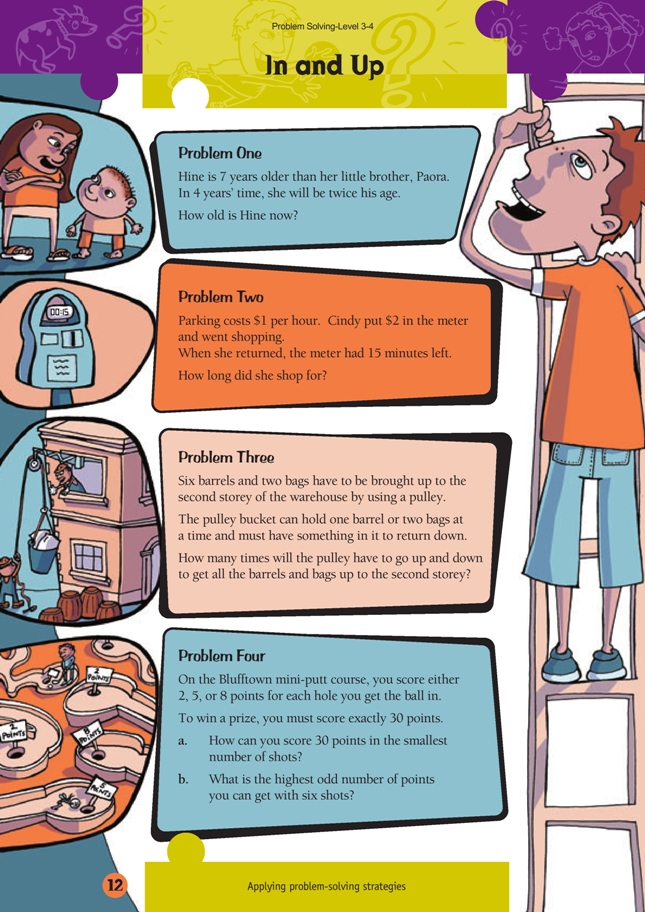These are level 3 number problems from the Figure It Out series.
A PDF of the student activity is included.
Click on the image to enlarge it. Click again to close. Download PDF (298 KB)
use addition and problem solving strategies to solve problems (Problems 1-4)
Problem One
Students can use trial and improvement to solve this problem. Recording their trials on a table will help.
There is always a 7 year difference in the ages, so if Hine is 10 years old now, in 4 years’ time she will be 14 and her brother will be 7.
Problem Four, page 3, in Problem Solving, Figure It Out, Level 3, is a similar problem that could be used as a warm-up.
Problem Two
This problem requires students to convert dollars, which divide into 100 cents, to hours, which divide into 60 minutes. They need to recognise that the 15 minutes shown on the parking meter as 00:15 is not the same as 0.15 hours.
Parking costs $1 per hour, and Cindy put in $2, which will pay for 2 hours. What proportion of 1 hour is 15 minutes? 15/60 is 1/4 of an hour, so Cindy has shopped for 2 hours minus the 15 minutes she has left, which is 13/4 hours.
Alternatively, the students might work out that if Cindy had let her money run out, she would have been away for 2 hours. But she has 15 minutes left, so she must have been away for 2 hours minus 15 minutes which is 13/4 hours.
A double number line could also be used to solve this problem:
Problem Three
The students could model this problem with equipment.
The first load up in the pulley bucket can either be one barrel or two bags. Some students may try to take one of the barrels up first, but then they won’t have anything to put in the bucket to go down (unless they just take the barrel back down, which achieves nothing). So the first load up must be two bags. One of the bags will go back down on the return journey. That will leave one bag at the top and six barrels and one bag at the bottom.
What should they send up in the next load? It could be the one bag, but that wouldn’t achieve anything because the bag would have to come straight back down again. But if they send one barrel up, they can leave it there and send the one bag at the top down on the return journey. That will leave one barrel at the top and five barrels and two bags at the bottom. The next move will have to be the two bags again, because if they send another barrel, they will have to send down the barrel at the top down in the return journey, which won’t achieve anything. So the two bags will go up again, and one will come down. Then another barrel can go up, and the bag at the top will come down.
Students will probably notice that this is a recurring pattern. To get one barrel up takes four trips up and down:
Trip 1: up with two bags
Trip 2: down with one bag
Trip 3: up with one barrel
Trip 4: down with one bag.
There are six barrels to go up, so after 6 x 4 = 24 trips, all six barrels will be at the top and the two bags will be at the bottom. One more trip is needed to get the two bags to the top, giving a total of 25 trips.
This problem is a slightly more complex version of the farmer and corn problem in Problem Three, page 10, in Problem Solving, Figure It Out, Level 3.
Problem Four
The students may try to solve this using trial and improvement, but using multiplication and division basic facts and their knowledge of multiplying and adding odd and even numbers is more efficient.
a. The students are looking for the smallest number of shots, so they could start by dividing 30 by the highest scoring hole (8). But 30 doesn’t divide evenly into 8s. They could try three shots of 8 to get 24 points and then another three shots of 2 to make 30. That’s six shots altogether. If they divide by the next highest scoring hole (5), they get exactly six shots (30 ÷ 5 = 6). The students can continue to experiment with different combinations of shots to check that six is the smallest number of shots. Obviously, most of the score of 30 will need to be made up of shots of 5 or 8; if most of the score is made up of shots of 2, they will need a lot more than six shots. The answers give the other two ways of scoring 30 from six shots.
b. The highest number of points gained by scoring 8 each time gives a total of 48. But, of course, 48 is even. To get an odd number, you have to score an odd number on one shot. So the highest odd number is scored by shooting five 8s and a 5, for a total of 45.
Hints for Students
1. Use trial and improvement and record your results on a table.
2. How much will it cost to park for 15 minutes?
3. Experiment with taking the bags and barrels up in different combinations.
Modelling the problem or using a table could help.
4. How can you use multiplication and division basic facts to help you?
Answers to Problems
1. 10
2. 13/4 hours
3. 25 times
4. a. The smallest number of shots needed to score 30 points is six. There are four ways of doing this:
b. 45



